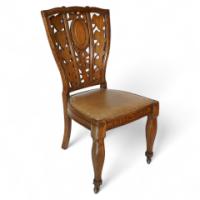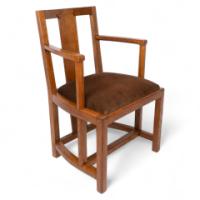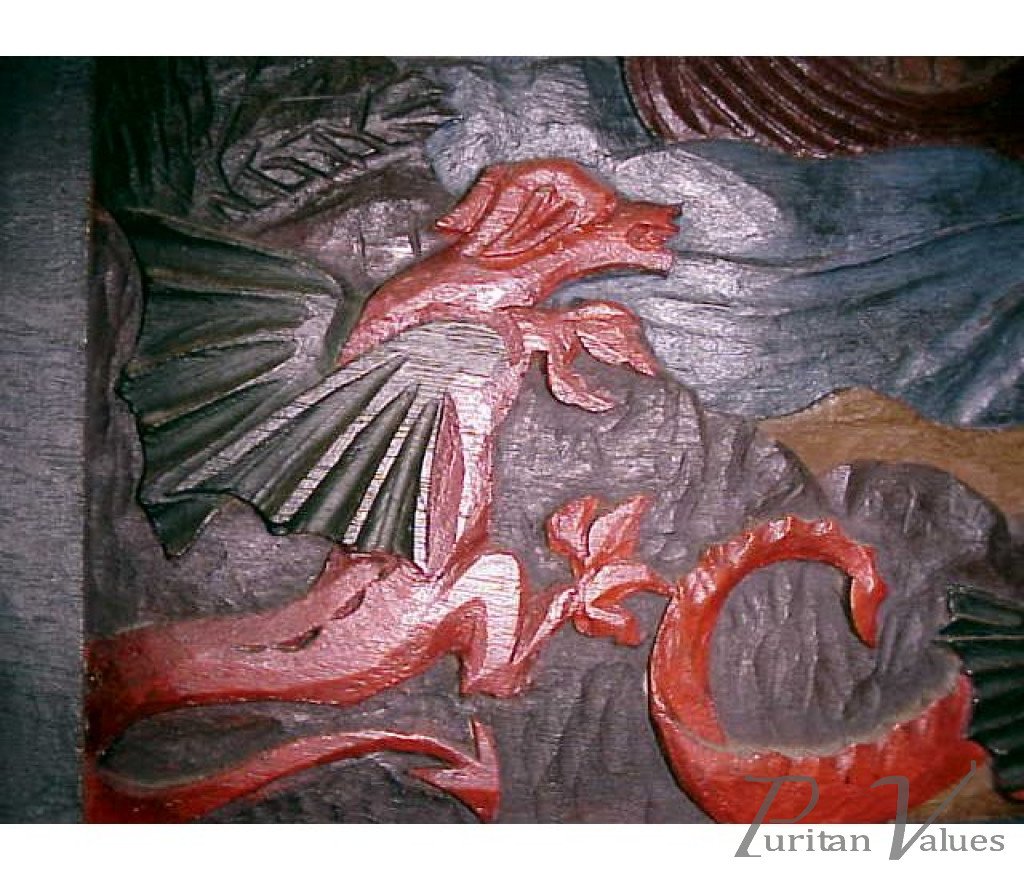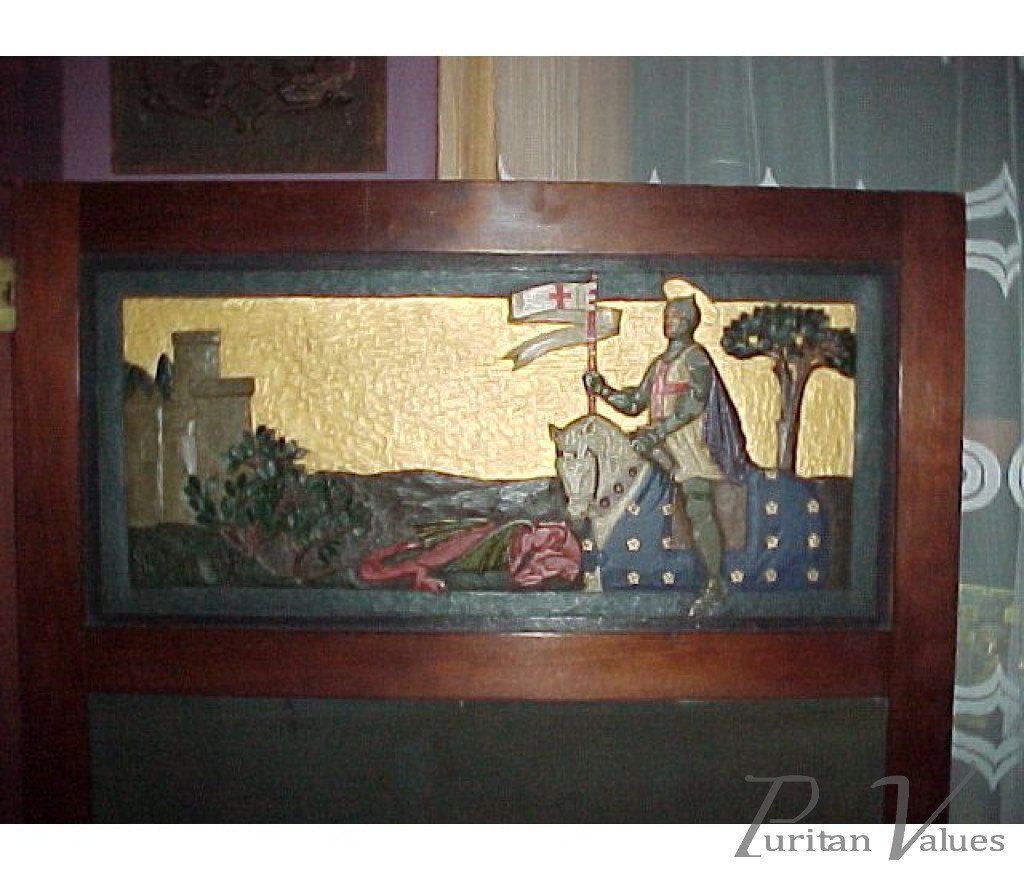Similar available products
Morris and Co (possibly). An outstanding pure Arts and Crafts three fold walnut screen
SOLD
About this piece
An outstanding pure Arts and Crafts three fold walnut screen depicting three scenes of three Saints and dragons with exceptionally skilled carving and intricate detail. The rich polychrome enamel colours bring this master piece vividly to life. The first scene is of St Michael slaying the Dragon and a tall flower to his left with flames lashing out from a cave I presume from the dragons mother within, then what looks like St Andrew the fisherman training or blessing baby dragons by the sea with a Galleon anchored just a little way out to sea and then finally St George upon his horse with the Dragon as if he has been mastered laying beside him as a pet would and with a castle in the background. The back has Gilt crosses within circles on a Green background. By Jennifer Edwards, 11/11/2007. This is very intriguing work of Art and a piece I am researching, it is quite possible that this is a rare Morris and Co piece, the polychrome colours and carvings are quite reminiscent of the work Morris and friends did at the Kensington Museum. If anyone could help with this then I would happily gift them a reward fitting that information. Many thanks Tony. The three folds of the screen form a triptych with each picture telling its own story but the whole portraying a far more important and broader narrative. Left Fold I think that this is definitely St Michael. The figure has the spear and sword (but no shield as is usual) and the dragon is shown under his foot – a typical stance. He is clothed in armour; this is usually chain mail but that might be very difficult to carve in hard walnut. He appears young and handsome as portrayed in Renaissance art. His holiness is accentuated by his head and halo lying in front of the green border unlike the top of his wings which lie behind. The dragon is large compared with those in the other scenes. It represents the Devil and the combined evil as enemies of God; that could account for its size. It is an old dragon: Satan is no longer young. The scene is taken from Revelations 12:7-9 The flower is not an attribute of St Michael as such. It looks quite like the way a lily is often depicted in medieval paintings. The lily depicts chastity and purity and, as such, is therefore associated with the Virgin. It is often shown as an attribute of the Archangel Gabriel because of the connection with the Virgin at the Annunciation. This is not Gabriel – too militant. However, there is a possible link with St Michael in that it could be a sapling of the Tree of Knowledge. St Michael instructed Eve to plant a branch of this on Adam’s grave. It grew, was transplanted by Solomon into the garden of the Temple and (quite a bit later in the story) was fashioned into the Cross on which Christ was crucified. This could account for the small gold cross in it centre. It acts as a link between St Michael and the Church. The Tree of Knowledge represents good and evil (Genesis 2:9) as does St Michael killing Satan. Right Fold The thirteenth century book, ‘The Golden Legend’ by Jacopo de Voragine, tells the story of St George. A terrible dragon was dominating the land around Slena, in Lydia. It lived in a marsh close to the town and a lake. The population sent human sacrifices to appease him. St George happened to be riding by when a young maiden, who was the daughter of the king, was about to be eaten by the dragon. He made the sign of the cross and was therefore empowered and able to slay the dragon. The King and town inhabitants were so impressed that they all converted to Christianity and were baptised. Once again, the dragon represents Evil and his slaying by St George is the triumph of good over evil or Christianity over paganism. There is another tree possibly depicting both good and evil. The picture shows the city walls and the lake in the background. St George wears a white tunic for purity and his helmet is of middle-eastern style of that time. He came from Capodocia in Turkey. Centre Fold This is the most interesting of the three paintings. I think that the figure represents Christ as a young man possibly at the time of His first temptation. Having been in the desert for 40 days and nights, He was tempted by the Devil (dragon) to turn the rocks into bread and so break His fast. However, there is not much in the picture to be so specific about such an episode. It could just portray Christ giving the benediction to the dragons/demons representing evil. He carries a staff as the Good Shepherd and has sandals on His feet. He appears to be clothed in blue which symbolizes Heavenly love and He is depicted wearing this colour while on earth. His seated position is one often used when He is preaching to a small group. The ship is an iconographical symbol for the Church; the early Christian fathers likened the Church to a ship in which the faithful found safety and were carried to salvation. St Ambrose was the first to liken the Church to a ship with the mast appearing as the Cross. This is very clear in this picture. I do not think that it has anything to do directly with the Miracle of the Fishes or Christ walking on water. There is another tree which again represents the Tree of Knowledge. A mix of good and evil. And Christ’s later crucifixion. It is close to the figure so relates to it closely. Alternatively, it could be an olive tree which, because of its fruitfulness with oil and olives, represents the bountifulness of God towards His believers. The dragon appears to have several heads and tails; it could represent a ‘multitude of evils’ instead of just Satan as an entity. Interestingly, the demons/dragons lie between the figure and the ship – this could represent the interference of the faith of the Church by the Devil by getting between Christ and His subjects. Overall I think the three pictures represent three manifestations of the triumph of God over the Devil or/and of Good over Evil. Each picture is painted in strong primary colours. Blue represents Heaven and heavenly love; green the colour of spring and the triumph of spring over winter. It is very interesting that the sky is gold in each of the paintings because this is the sign of divinity and indicates the sacredness of what is depicted. Thus, the sky acts as a sacred backdrop to the scenes in the foreground as well as the haloes indicating the sanctity of the individual figures. The dragons are interesting in that they appear to be multi-headed and multi-tailed with wings. Evil can be represented by dragons, demons or snakes. Some of the dragons here appear to be hybrids. There used to a fabulous depiction of evil called the basilisk. It was supposed to be half cock and half snake but I have seen a drawing of one which looks exactly like the dragon in the centre picture. It used to be an accepted medieval symbol of the Devil or Antichrist and could kill at a glance. It was originally mentioned in the Book of Psalms. St Augustine included it in his four aspects of the Devil which were downtrodden by the triumphant Christ. The basilisk was well established in the Middle Ages but not used as a symbol in the Italian Renaissance so is not found very frequently. Ideas about Age and Origin of the Screen As a piece of furniture I am not qualified to identify the screens age. However, it does seem to be an extremely interesting and (I would guess) valuable piece because of its uniqueness. I have not been able to find another that is remotely like it in any books I have researched. I think it could be an important work. The following are just a few ideas, thoughts and suggestions (in no particular order): The use of walnut is interesting in that it could have been used for a wealthy client such as a church or senior clergyman. I would think that it was certainly made as a one-off for a client who lived in a Victorian-Gothic pile or an ecclesiastical setting. That would tie in with the richly decorated back and all the crosses. The topics of the paintings are in a medieval style of polychromed bas-relief carving. The subject matter implies a Catholic patron. This is not a Church of England piece – too many devils and too much iconography. There was a marked upsurge in Catholic furniture after the Catholic Emancipation Act of 1829. many new catholic churches were built with associated presbyteries etc. – all requiring furniture N.B. This interpretation has drawn on: Ferguson, George ‘Signs and Symbols in Christian Art’ (Oxford University Press: Oxford, 1961) ‘Hall’s Dictionary of Subjects and Symbols in Art’ (Murray: London, 1979) De Voragine, J., ‘The Golden Legend’, (Penguin: London) Height 179cm, each panel 70cm wide.











































